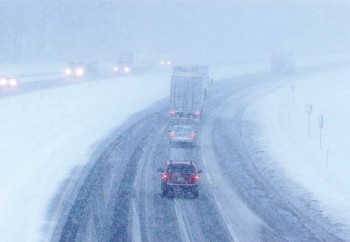written by Worksafe BC
Motor vehicle crashes are a leading cause of workplace deaths in British Columbia. Winter conditions – such as freezing temperatures, rain, snow, black ice and reduced daylight hours – create additional hazards for occupational drivers, whether they drive a vehicle full time, or just as part of their job.
If you drive a company or personal vehicle for work, the following information will help reduce your risk of a crash during the winter driving season (October 1 to March 31).
(Please note: the information on this tip sheet is primarily designed for fleets that operate passenger cars and light- duty trucks. If your organization operates commercial vehicles with a GVW in excess of 5000 kg, please consult other information sources on ShiftIntoWinter.ca.)
Understand Your Legal Responsibilities
- Know your responsibilities under the Workers Compensation Act and the Occupational Health and Safety Regulation. (Visit WorkSafeBC.com and BCLaws.ca and for more information.)
- Follow your organization’s safety policies, rules and procedures. Know your responsibilities under the Motor Vehicle Act and Motor Vehicle Act Regulations. If you drive a vehicle outside of B.C., follow the applicable laws and regulations in those jurisdictions.
- Do not work (or drive) while impaired. Impairment can have many causes: alcohol or drugs, even prescription or some over-the counter drugs, can cause impairment. Lack of sleep is another cause of impairment.
- Report all hazardous conditions. You have the right to refuse work that you think is unsafe.
- Get involved – make safety suggestions to your supervisor, the company safety representative or safetycommittee.
Report Hazards
- Report workplace and road hazards – such as poor weather, vehicle or road conditions – to your supervisor.
Determine When Work Driving is Necessary
- Where possible, eliminate the hazards associated with winter driving by first exhausting all other means of conducting business (e.g., by e-mail, telephone, video conferencing, making use of public transportation etc.). By limiting vehicle trips, you will reduce your personal risk, reduce costs and improve the environment.
When Driving is Necessary
Safe trips are planned trips. When driving is required, ensure that you:
- Prepare yourself
- Prepare your vehicle (especially if you drive yourown car for work)
- Drive for the conditions
Prepare Yourself
- Understand the importance of safe seasonal driving. Visit ShiftIntoWinter.ca for more information.
- Check current weather and road conditions before driving. Go to DriveBC.ca.
- Revise your travel schedule depending on the weather, road hazards, time of day, etc.
- Ask for winter driving training.
- Ninety percent of vehicle crashes are caused by human error.
- Complete a pre-trip inspection and “circle check” (a walk around your vehicle to inspect on the overall condition of your vehicle and possible reversing hazards) before each journey.
- Follow your organization’s working alone procedure. (See WorkSafeBC.com for more information on this worker safety regulatory requirement.)
- Follow your organization’s procedures if you become stuck or stranded (e.g., stay with the vehicle for safety and warmth; have a cell phone to call for roadside assistance or 911 in an emergency).
Prepare Your Vehicle
- Report any vehicle concerns to your supervisors (e.g., issues with tires, battery, brakes, cooling and heating systems, etc.)
- Review your vehicle’s maintenance record. If scheduled maintenance is due, take it in for repair.
- Scrape all snow and ice from windows, lights, mirrors and vehicle surfaces before driving. (An ice scraper with a long handle will help you reach.) In addition, windows should be completely defrosted.
- Check your tire pressure at least once per month, or more, depending on temperature changes. (Tire pressure drops in colder conditions.)
- Use winter tires – they provide better traction in cold weather (7°C or less) and in snow, slush, and icy conditions. Ask to have four matched winter tires installed on your fleet vehicle. Install winter tires on your personal car or truck if the vehicle is driven for work. Winter tires must carry the winter tire logo.
- If your employer provides tire chains, ask for training on how to correctly install them. Always mount chains in a safe area away from busy roads. Wear an approved high visibility vest and activate your vehicle’s hazard lights.
- Keep your gas tanks full to avoid condensation, which can cause fuel lines to freeze.
- Carry a winter survival kit that includes an appropriate first aid kit, an approved high-visibility vest, additional windshield washer fluid, flares, matches or a lighter, shovel, traction mat, sandbags (for extra weight and traction), flashlight and extra alkaline batteries, battery jumper cables, spare tire, wheel wrench and a jack.
Drive For the Conditions
- Pay full attention to your driving and the road ahead. When you are behind the wheel, driving is your only job.
- Allow extra time for work travel. Adjust your schedule so you aren’t rushing to get to your destination.
- Slow down when driving. Posted speed limits are for ideal road conditions. Reduce your speed, depending on the conditions.
- Make sure you are able to see and be seen in low light conditions, blowing snow or whiteouts. Visibility is critical. Limit your driving time at night.
- Increase the distance between your vehicle and the vehicle driving in front of you. Always accelerate andbrake slowly.
- Use caution when approaching highway maintenanceequipment.
- Be prepared to meet driving challenges such as limited visibility in adverse weather conditions, pedestrians or cyclists wearing dark clothing.
- Understand and avoid the hazards of seasonal rain and fog:
– Light rain mixed with residual oil can make road conditions slick.
– Heavy rain creates conditions ideal for hydroplaning.
– Fog can reduce visibility of the road ahead to as little as the front of the vehicle. Driving in fog should be avoided whenever possible. - Understand and avoid the hazards of snow and ice:
– Hard-packed snow on a road can be as slippery as ice. Snow can also be rutted and full of hard tracks and snow “gullies” that can throw your vehicle off track.
– Wet snow can make for slushy roads. Heavy slush can build up in the wheel wells and affect your ability to steer.
– Slush and spray from other vehicles can cause sudden loss of visibility.
– Ice forms on roads in shaded areas, on bridges and overpasses – these sections of road often freeze much sooner and stay frozen long after the sun has risen.
– Sections of the road that appear black and shiny have frosted over and can cause a vehicle to suddenly lose traction. - Familiarize yourself with the vehicle’s controls and take a few moments to adjust side and rear-view mirrors and your seat position, especially if you don’t drive the same vehicle every day.
- Plan, and take, rest breaks along the way if you travelover longer distances.
Additional Resources
Know before you go.









